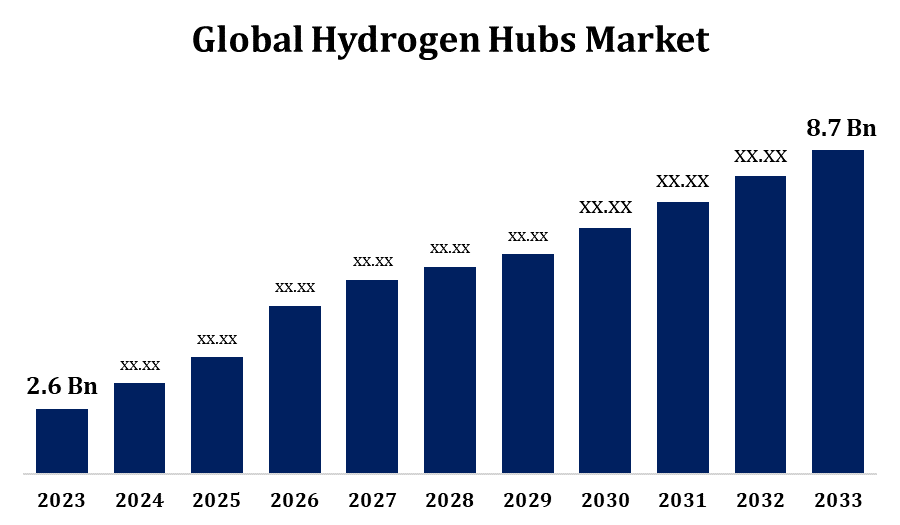Global Hydrogen Hubs Market worth USD 8.7 billion by 2033 | CAGR of 12.84%
Category: Aerospace & DefenseGlobal Hydrogen Hubs Market worth USD 8.7 billion by 2033
According to a research report published by Spherical Insights & Consulting, the Global Hydrogen Hubs Market Size to grow from USD 2.6 billion in 2023 to USD 8.7 billion by 2033, at a Compound Annual Growth Rate (CAGR) of 12.84% during the forecast period.

Get more details on this report -
Browse 333 market data Tables and 47 Figures spread through 210 Pages and in-depth TOC on" Global Hydrogen Hubs Market Size, Share, and COVID-19 Impact Analysis, By Type (Liquid Hydrogen and Hydrogen Fuel Cells), By Supply Technique (Steam Methane Reforming (SMR) and Electrolysis), By End-use (Automotive, Marine, Space, Aviation, Defense, and Others), and By Region (North America, Europe, Asia-Pacific, Latin America, Middle East, and Africa), Analysis and Forecast 2023 - 2033." Get Detailed Report Description Here: https://www.sphericalinsights.com/reports/hydrogen-hubs-market
The hydrogen hubs market is rapidly growing as governments and industries focus on clean energy solutions to address climate change. These hubs, which consist of integrated systems for production, storage, and distribution, are essential for the global shift toward a low-carbon economy. They facilitate large-scale hydrogen production, especially green hydrogen generated from renewable sources such as wind and solar energy. Significant investments from both public and private sectors are fueling the development of hydrogen hubs in regions like Europe, the US, and Asia, aiming to decarbonize sectors such as heavy industry, transport, and power generation. The market's growth is driven by strategic partnerships, technological innovations, and favorable policies, creating economic opportunities and enhancing energy security. With rising demand for clean energy, the hydrogen hubs market is set for substantial expansion.
Hydrogen Hubs Market Value Chain Analysis
The hydrogen hubs market value chain consists of several key stages, each essential for the effective deployment of hydrogen as a clean energy solution. The process begins with hydrogen production, where green hydrogen is produced through electrolysis powered by renewable energy or from natural gas via steam methane reforming with carbon capture. Following this, storage and transportation infrastructure, including pipelines, liquefaction facilities, and distribution networks, ensures the safe and efficient delivery of hydrogen. End-users, such as industries, transport sectors, and power plants, play a critical role in adopting hydrogen to reduce emissions. Technology providers, including electrolysis and fuel cell developers, drive innovation. Lastly, government policies and regulations set the foundation for investments, incentives, and market integration, accelerating the development of hydrogen hubs.
Hydrogen Hubs Market Opportunity Analysis
The hydrogen hubs market presents substantial opportunities, fueled by the global drive for decarbonization and clean energy solutions. With the introduction of supportive government policies, such as carbon pricing and subsidies, the demand for green hydrogen is set to rise, particularly in regions rich in renewable resources. Hydrogen hubs have the potential to transform industries like transportation, steel manufacturing, and power generation by offering a sustainable alternative to fossil fuels. Moreover, the growth of hydrogen infrastructure can stimulate job creation and boost regional economies. Investments from the private sector in hydrogen technologies, including electrolysis, fuel cells, and storage, further strengthen market prospects. Collaborative efforts between industry players and governments are expected to drive innovation, accelerate scaling, and reduce costs, making hydrogen hubs a promising avenue for sustainable energy development in the coming years.
The growing focus on sustainable energy is driving the rapid growth of the hydrogen hubs market. As countries intensify efforts to meet climate goals through decarbonization, the demand for clean and renewable energy sources is increasing. Hydrogen, especially green hydrogen, is emerging as a critical solution to reduce carbon emissions in sectors such as transportation, heavy industries, and power generation. Governments are introducing supportive policies and incentives to accelerate the adoption of hydrogen technologies, further fueling market expansion. In addition, rising investments in renewable energy infrastructure, like wind and solar power, are enhancing the growth of hydrogen hubs. As the world transitions to a low-carbon economy, the shift towards sustainable energy is fostering new opportunities for innovation and the development of hydrogen hubs, driving the market's overall success.
A major challenge in the hydrogen hubs market is the high cost of producing green hydrogen, particularly through electrolysis, which remains expensive compared to conventional fossil fuels. The insufficient infrastructure for hydrogen storage and transportation also presents a significant hurdle, as it requires specialized pipelines, storage systems, and distribution networks. Additionally, technological constraints in hydrogen production, storage, and fuel cell efficiency hinder widespread adoption. Regulatory challenges, including inconsistent policies across regions, can create uncertainty for investors. Public concerns about hydrogen safety and its environmental impact may further slow its adoption, especially in areas where hydrogen infrastructure is underdeveloped. Overcoming these challenges will require innovation, collaboration, and supportive government policies to unlock the full potential of hydrogen hubs.
Insights by Type
The hydrogen fuel cells segment accounted for the largest market share over the forecast period 2023 to 2033. Hydrogen fuel cells are gaining momentum in transportation, especially in electric vehicles (EVs) and heavy-duty sectors like trucks, buses, and trains, providing an efficient alternative to traditional fossil fuel-powered engines. Furthermore, fuel cells are increasingly being used in stationary power generation systems, helping industries reduce their carbon footprint. The development of hydrogen hubs, which offer the necessary infrastructure for fuel cell integration, is further fueling this growth. Government incentives and regulations promoting zero-emission technologies, along with improvements in fuel cell efficiency and cost reductions, are driving the market’s expansion. As fuel cell technology becomes more affordable and scalable, its role in the hydrogen economy is poised for substantial growth.
Insights by Supply Technique
The Steam Methane Reforming (SMR) segment accounted for the largest market share over the forecast period 2023 to 2033. Steam Methane Reforming (SMR) is currently the most widely used method for hydrogen production, especially in regions rich in natural gas resources. As a relatively cost-effective process compared to green hydrogen production, SMR remains a dominant technology, despite its associated carbon emissions. To address environmental concerns, many hydrogen hubs are integrating Carbon Capture, Utilization, and Storage (CCUS) technologies alongside SMR, enabling more sustainable hydrogen production. This combined approach is gaining traction in markets where cost-effectiveness is crucial during the initial stages of hydrogen infrastructure development. The growth of the SMR segment is driven by its ability to provide a reliable hydrogen supply to industries such as petrochemicals, refining, and power generation, which depend on hydrogen for various processes.
Insights by End Use
The automotive segment accounted for the largest market share over the forecast period 2023 to 2033. This segment is gaining momentum due to hydrogen's ability to refuel quickly and offer a longer driving range compared to battery-powered vehicles. Many automotive manufacturers are investing in hydrogen fuel cell technology, and governments are providing incentives to encourage the adoption of fuel cell electric vehicles (FCEVs). The establishment of hydrogen hubs, which supply the essential refueling infrastructure, is key to the growth of this market segment. As hydrogen technology improves and becomes more cost-effective, the automotive sector's contribution to hydrogen adoption is expected to grow significantly, further driving the expansion of the hydrogen hubs market.
Insights by Region

Get more details on this report -
North America is anticipated to dominate the Hydrogen Hubs Market from 2023 to 2033. The United States and Canada are at the forefront of establishing hydrogen hubs, with substantial investments from both public and private sectors. The U.S. government has launched programs like the Hydrogen Hub Grant Program to support the development of hydrogen infrastructure in multiple states. Key industries, including transportation, steel manufacturing, and power generation, are increasingly turning to hydrogen as a sustainable alternative to fossil fuels. Canada's abundant renewable energy resources, particularly hydroelectric power, provide a competitive edge for green hydrogen production.
Asia Pacific is witnessing the fastest market growth between 2023 to 2033. Japan is striving to establish itself as a global hydrogen leader, while South Korea is concentrating on hydrogen fuel cells and developing regional hydrogen hubs. China, with its vast renewable energy resources, is expanding green hydrogen production. The region's industrial sectors, such as transportation, manufacturing, and power generation, are increasingly adopting hydrogen to cut carbon emissions. However, challenges like high production costs, infrastructure limitations, and regulatory inconsistencies persist. Despite these hurdles, Asia Pacific’s strategic investments and government backing position it as a critical player in the global hydrogen economy.
Recent Market Developments
- In February 2024, Air Products and Eneco have entered into an agreement to procure solar electricity in the Netherlands, reinforcing Air Products' dedication to addressing climate change and meeting a significant portion of its energy needs in the country through renewable sources.
Major players in the market
- Airbus
- Linde plc
- Scotland
- ARAMCO
- Aranca
- Shell plc.
- Sinopec
Market Segmentation
- This study forecasts revenue at global, regional, and country levels from 2023 to 2033.
Hydrogen Hubs Market, Type Analysis
- Liquid Hydrogen
- Hydrogen Fuel Cells
Hydrogen Hubs Market, Supply Technique Analysis
- Steam Methane Reforming (SMR)
- Electrolysis
Hydrogen Hubs Market, End Use Analysis
- Automotive
- Marine
- Space
- Aviation
- Defense
- Others
Hydrogen Hubs Market, Regional Analysis
- North America
- US
- Canada
- Mexico
- Europe
- Germany
- Uk
- France
- Italy
- Spain
- Russia
- Rest of Europe
- Asia Pacific
- China
- Japan
- India
- South Korea
- Australia
- Rest of Asia Pacific
- South America
- Brazil
- Argentina
- Rest of South America
- Middle East & Africa
- UAE
- Saudi Arabia
- Qatar
- South Africa
- Rest of the Middle East & Africa
About the Spherical Insights & Consulting
Spherical Insights & Consulting is a market research and consulting firm which provides actionable market research study, quantitative forecasting and trends analysis provides forward-looking insight especially designed for decision makers and aids ROI.
Which is catering to different industry such as financial sectors, industrial sectors, government organizations, universities, non-profits and corporations. The company's mission is to work with businesses to achieve business objectives and maintain strategic improvements.
CONTACT US:
For More Information on Your Target Market, Please Contact Us Below:
Phone: +1 303 800 4326 (the U.S.)
Phone: +91 90289 24100 (APAC)
Email: inquiry@sphericalinsights.com, sales@sphericalinsights.com
Contact Us: https://www.sphericalinsights.com/contact-us
Need help to buy this report?